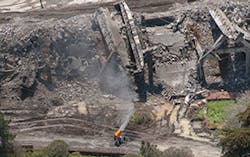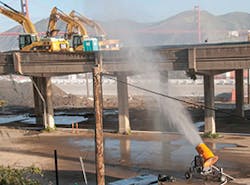Originally constructed in 1936, Doyle Drive is a busy thoroughfare that carries thousands of cars per hour in peak traffic periods. In 1990 it underwent a full seismic evaluation and was determined to have reached the end of its useful service life, deemed structurally and seismically deficient due to the ravages of time and continuous use. Its replacement would be an entirely new Presidio Parkway design, including two short tunnels, a wide landscaped median and engineered transitions to city streets to ease traffic and improve safety. When completed, the new parkway will also produce a dramatic visual change, as the bulky concrete Doyle Drive structures are removed to reveal striking views of the Presidio and San Francisco Bay.
In 2010, Phase I of the project got under way in the springtime, with the construction of a tunnel and detour roadway to shift traffic completely off of Doyle Drive. Demolition of the old structure began in 2012, involving approximately 4,700 linear feet of roadway, including some 150 spans in three distinct structures. Yet the plan required that the road be completely closed for just one weekend to demolish the entire length.
“There was only a 57-hour window to demolish the existing structure and complete construction of the bypass before we had to reopen the roadway to vehicle traffic,” explained Andrew Yan, resident engineer with the California DOT. “The structure was divided into four main components, all to be demolished within the same time frame. It was a tall order, but we planned out every detail.”
The takedown required a fleet of 40 pieces of demolition equipment, including 20 hydraulic excavators outfitted with such work tools as hammers, grapples, pulverizers, and shears. Crews also used backhoe loaders, track loaders, wheel loaders, and articulated dump trucks, all running continuously to meet the tight deadline.
Because of its proximity to the Presidio, a historic park that remained open to the public during demolition, the contract called for a dust control plan to prevent all visible dust from leaving the project boundaries while work was under way.
“In some places, the public areas were less than 100 feet away from the demolition activity,” Yan continued. “There’s also a residential neighborhood and business corridor adjacent to Doyle Drive. In addition, we had to consider the nearby marsh, wetlands, and forest, as well as the wildlife within those habitats.”
With dust suppression such a high priority, CalTrans researched a number of equipment options to supplement traditional water trucks and manual spraying. “Because we had simultaneous demolition in four distinct locations on this project, we needed dust control over a very wide area,” he observed. “But the manpower we could commit to that was limited. The initial equipment designs we reviewed didn’t convince us that they could deliver the coverage we required.”
Yan remembered that another CalTrans project faced similar dust suppression issues, on the Oakland Bay Bridge West Approach in San Francisco. He knew that engineers had successfully controlled the demolition dust on that job with large atomized misting units from Dust Control Technology, of Peoria, IL. After reviewing specifications on the various models and discussing the project requirements with DCT, he arranged a rental of eight DustBoss DB-60s, with onsite training supplied by the manufacturer.
Dust Management by Design
One of the best-known designs in the DustBoss product family, the DB-60 is a large-scale suppression unit with special atomizing nozzles that create an “engineered mist,” sizing the droplets specifically for optimum dust control (typically 50-200 microns). A powerful 25-horsepower fan launches the droplets over long distances, allowing one full-oscillation machine to cover nearly 125,000 square feet (more than 11,600 square meters) with a highly efficient dust-trapping mist.
The DB-60 represents one of the few suppression technologies that’s effective on both ground level dust and airborne particles. When particle sizes or service environments dictate, DustBoss designs are also engineered to allow a wide range of customizations, including the company’s variable particle sizing (VPS) technology. Using a variety of nozzle sizes, shapes, patterns and flow, DCT can tailor the mist output to suit specific dust particle sizes and extreme conditions.
Usually supplied on a wheeled carriage or rugged skid mount, the DB-60’s design is based on 40 years of engineering experience in atomized mist technology, which has come to be recognized as a complex technical equation. In addition to water flow, droplet size, and air speed, there are dozens of variables that affect a machine’s performance. The size and precise shape of the barrel are critical, for example, to control the laminar air flow and achieve the optimal plume and distance.
DCT designers have also optimized the integrated fan shape and blade pitch, nozzle components, inlet valves, pumps and filters. In essence, each equipment design is the sum of all its parts. Every component must be specifically engineered to maximize performance, as failure to consider any one of the details will detract from the unit’s effectiveness and/or durability.
Equipped with a 10-horsepower booster pump to increase water pressure as much as 150 PSI from a 2-inch supply hose, the DB-60 has an adjustable elevation angle from 0 to 50 degrees. The unit can also be outfitted with a dosing pump to accommodate odor control additives or surfactants to further enhance binding of dust particles.
Like all of the company’s fan-based atomizers, the DB-60 delivers its power and reliability by using a straightforward, direct-drive fan motor. It has no drive belts, diesel engines, or complex gear systems that could present dependability problems in the difficult service environment of a demolition site, coal mine, or recycling yard. Despite its size, the machine requires minimal maintenance: Lubrication of fan motor bearings is recommended every 10,000 hours, while the oscillation motor is lubricated for life.
The atomizing nozzles of this dust supression unit create an “engineered mist.”
Results
In California DOT work sites, dust control is no longer a luxury but a contractually mandated component of demolition, construction, and certain types of maintenance work, subject to inspection. “Particularly in the city and greater San Francisco Bay area, dust suppression strategies and techniques are constantly being reviewed and refined,” Yan continues. “Overall, there’s been an increasing focus and scrutiny on developing multipronged approaches to site maintenance, including dust management and water pollution prevention.”
With the increase in materials recycling onsite, and trends toward tighter regulation of job site effluent of all kinds, industry professionals are more motivated than ever to find efficient, cost-effective methods of dust suppression.
With the significant reduction in airborne dust, Yan and his crews contributed to a healthier workplace on the complex Doyle Drive demolition project, while protecting the surrounding communities and natural environment.
“I was particularly impressed by the range of the unit, and the relatively low noise level during operation,” he says. “The ability to easily mobilize and relocate the units as needed was also a big advantage on this job.” In addition, effective suppression minimized the opportunity for abrasive dust to enter air intakes on heavy equipment, extending air filter life and reducing the potential for unnecessary wear.
“This was a very high-profile job,” Yan adds. “Our goal was to take all practical measures, using the best technology available, to mitigate the demolition dust and safeguard people, property, and the environment. I would recommend the DustBoss on future contracts of this type.”



